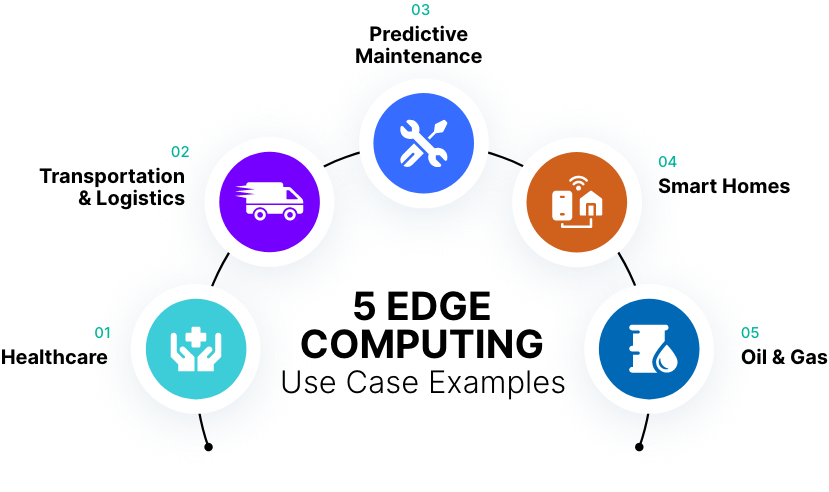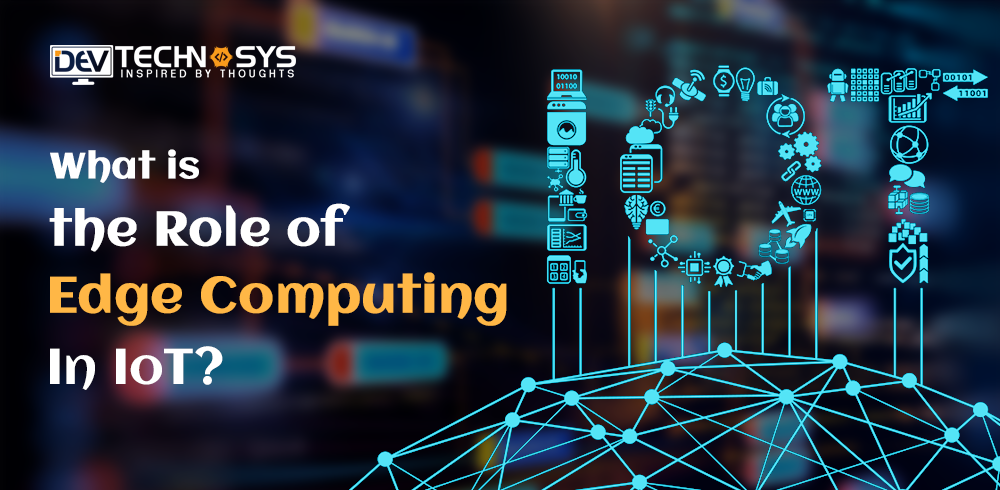Do you know What is the Role of Edge Computing In IoT?
In this modernized era, the Internet of Things (IoT) is developing fast and advancing towards the Internet of Everything (IOE).
The surge in the number of device connections and IoT data has increased the importance of edge computing development.
The invention of IoT edge computing has resolved latency issues associated with the cloud as it produces data close to its point of origin.
As per research, there will be around 42 billion connected IoT devices by 2025, generating 79.4 zettabytes of data. Edge computing is one of the reasons behind this, as IoT edge architecture brings enhanced safety and a smoother end-user experience.
| IoT Edge Computing Architecture | |
|
Cloud |
Cloud Modules Legacy Cloud Apps Edge Run time
|
|
Gateway |
Edge Modules Gateway Services
|
IoT and edge computing together, when combined, act as powerful assets to analyze data rapidly in real-time. As a result, it has raised the demand for IoT development company in today’s time, and ultimately businesses are incorporating IoT in edge computing.
However, some aren’t even aware of the role of IoT in edge computing. If you are one of them, this blog is for you. So, let’s start with the basics of edge computing and its role in IoT.
What Is Edge Computing?
Gartner defines edge computing as – A part of distributed computing topology where processed information is located near the edge that people consume.
In other words, edge computing is processing and analyzing data at the network edge closest to the point of action. Edge computing devices apply an on-device approach to information/data, which is stored locally rather than sending endless data streams to the cloud.
Role of Edge Computing In IoT: An Overview
Edge computing serves multiple business purposes in the world of the IoT landscape. The distributed computing paradigm untethers IoT devices from connectivity and latency issues while resolving the impossible IoT use cases.
This essential technology forms the backbone of IoT application development, including low-latency decision making, real-time data requirement, data classification, and more.
As per the industrial IoT scenario, edge computing devices help reduce the risk of data breaches and downtimes while effectively managing all the data and information.
Moreover, as per the IoT application development services professionals, manufacturers using edge computing consider workers’ safety a major advantage.
Overall, IoT enabled edge computing platforms to analyze the data from IoT devices at the local network edge and transmit it to the cloud for faster and redundant IoT processing that is readily scalable.
IoT & Edge Computing: How It Works?
IoT sensors generate a wide range of data that can instantly be transferred, processed, and stored using cloud computing.
Whenever businesses require data, the cloud analyses the data received before sending its response to the device. The entire process generally takes a few seconds, but there might be a possibility of delay or interruption.
When different types of edge computing are used with IoT devices, it is not required to send data from the sensors anywhere.
Instead, the nearest network node is responsible for data processing and immediate response whenever an action is taken. As a result, the devices are no longer dependent on the internet connection and can use function as standalone network nodes.
Read also: How to Build an App for The Internet of Things (IoT)
Majorly, edge computing and IoT are used together to meet the following requirements –
• Enables fast internet connectivity with IoT terminals by adapting to various physical interfaces & protocols.
• Manages a huge number of terminal devices in a centralized manner.
• Promotes quick response and allows the processing of local traffic on a local level.
• Allows for industry collaboration by opening up systems.
This is how edge computing works with IoT and brings work efficiency and smooth performance. Well, there are other reasons too, why edge computing devices and IoT are becoming the talk of the town.
Benefits of Edge Computing in IoT for Businesses

Edge computing solutions bring a list of numerous benefits to the IoT. Reduced latency, lower costs, local data storage, improved resiliency, and availability are a few. Let’s look at the major benefits of using edge computing solutions in IoT for businesses.
1. Reduce Operational Costs
Edge computing enables organizations to reduce bandwidth costs with the data processing before it crosses the WAN. For instance, a single city-deployed video camera generates 1,296GB/month, further increasing the cost.
Here, adding edge computing to pre-aggregate the data reduces those costs significantly.
Even the manufacturers use cloud computing for preventive maintenance of remote machinery. It filters the data, and only threshold violations and anomalies are sent to the cloud.
2. Improved Data Security
In today’s world, there is a huge risk for businesses with enterprise mobility solutions and continuous data transmission from the device to the cloud.
Edge computing decentralizes and distributes data among multiple devices, making it difficult for hackers to take down the whole network with a single attack. This, in turn, improves data security to a great extent, which would benefit businesses.
3. Reduced Latency
Many business applications have strict latency requirements, but latency could be a matter of concern when it comes to application safety.
This is where edge computing comes in handy, as it can speed up communication between the cloud and edge devices. In addition, edge computing platforms help bring the processing power closer to the devices, significantly reducing the strain and latency.
Read also: What is The Impact of IoT on The Business Sector in 2022?
4. Better Cybersecurity
Implementing IoT edge computing solutions helps businesses improve Cybersecurity while keeping IoT devices safe from attack.
Cloud data are more vulnerable to attacks due to their centralized nature, and even hackers try to break the information into a single network.
This is where distributing information to multiple devices or networks using edge computing will result in improved Cybersecurity. Keeping business data secure is more important for success, and maybe this is why businesses are availing of IoT app development services from well-known organizations.
5. Advanced Scalability
Rapid business scalability is a must in the IoT era, and distributed edge nodes are more scalable than large data centers. Unlike the cloud, incorporating edge computing allows businesses to scale up their IoT networking without any reference to the available storage.
Undoubtedly, it is difficult for businesses to scale up physical infrastructure in less time, but with edge computing architecture, businesses can make it possible. In addition, this approach offers businesses more scalability and understanding of their network.
5 Edge Computing Use Case Examples
Edge computing devices bring storage capabilities and computing closer to where it is required. To date, edge computing IoT has benefitted multiple sectors.
Here are a glimpse of the edge computing use case examples that will give you a clear overview of sectors reaping the benefits of IoT-enabled edge computing solutions in today’s time.

1. Healthcare
When it comes to the healthcare sector, ample monitoring software is available that gathers enormous data that is unprocessed and needs to be stored on a third-party cloud.
As a result, it has become a serious concern for healthcare professionals. To resolve this, businesses have started incorporating IoT edge computing devices during healthcare software development that maintains data privacy and provide real-time notifications to practitioners.
2. Transportation & Logistics
Manual transportation and logistics services increase fuel, drivers, and costs. To reduce such expenses, autonomous vehicles come in handy.
They not only save fuel costs but also decreases congestion. With edge computing solutions, now it is possible to remove drivers and turn vehicles completely autonomous.
3. Predictive Maintenance
Almost every business wants to detect bugs and errors before affecting them and their applications. Edge computing could be a savior in such a situation as it brings processes and data storage closer to the equipment.
In addition, it will enable IoT sensors to monitor machine health and perform real-time analytics. So, when you implement mobile app maintenance, add edge computing solutions with it.
4. Smart Homes
With the advancement in tools and technologies, people are switching to a smart home with IoT-enabled devices that quickly gather and process data from in and around the house.
The data is further sent to the centralized remote server, where it is stored. So, businesses offering similar services or IoT app development can think of implementing edge computing and the Internet of Things.
5. Oil & Gas
Oil & gas is a vast industry, and the demand for online oil and gas fuel delivery is increasing every passing day. As a result, businesses are incorporating edge computing IoT solutions to make their oil and gas software more efficient and successful.
These are some real-life examples of business success after incorporating edge computing IoT solutions. Each of the sectors mentioned above avails tremendous business benefits with edge computing, so businesses can think of it and take their business to the heights of success.
Final Thoughts!
The Internet of Things has become a critical component of modern industrialization and business operations. Today, smart building infrastructure, real-time monitoring operations, and autonomous robotics are all aided by IoT solutions.
However, with the rise in IoT solutions, internet access will become even more important. This is where edge computing can incorporate the Internet of Things (IoT) to reduce latency, improve connectivity, and facilitate scalability.
Edge computing solutions aid businesses in securing their networks and safeguarding their data from the growing threat of cybercrime.
So, what are you waiting for? Avail IoT development services from professionals and leverage IoT-enabled edge computing solutions to generate desired sales and profit.
At Dev Technosys, we have a team of dedicated developers who can help you with IoT application development. Just drop your business requirements and leave the rest to us.




























